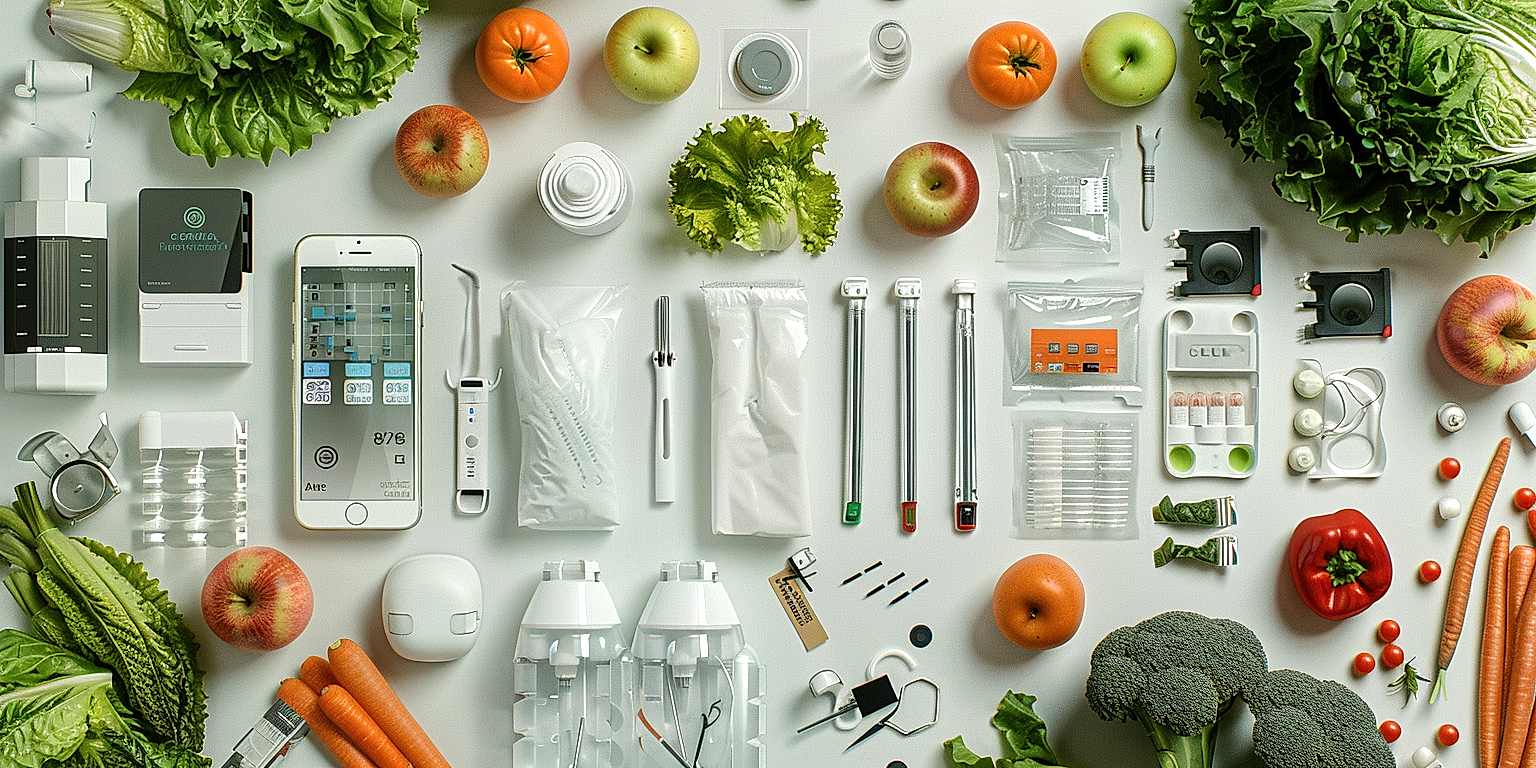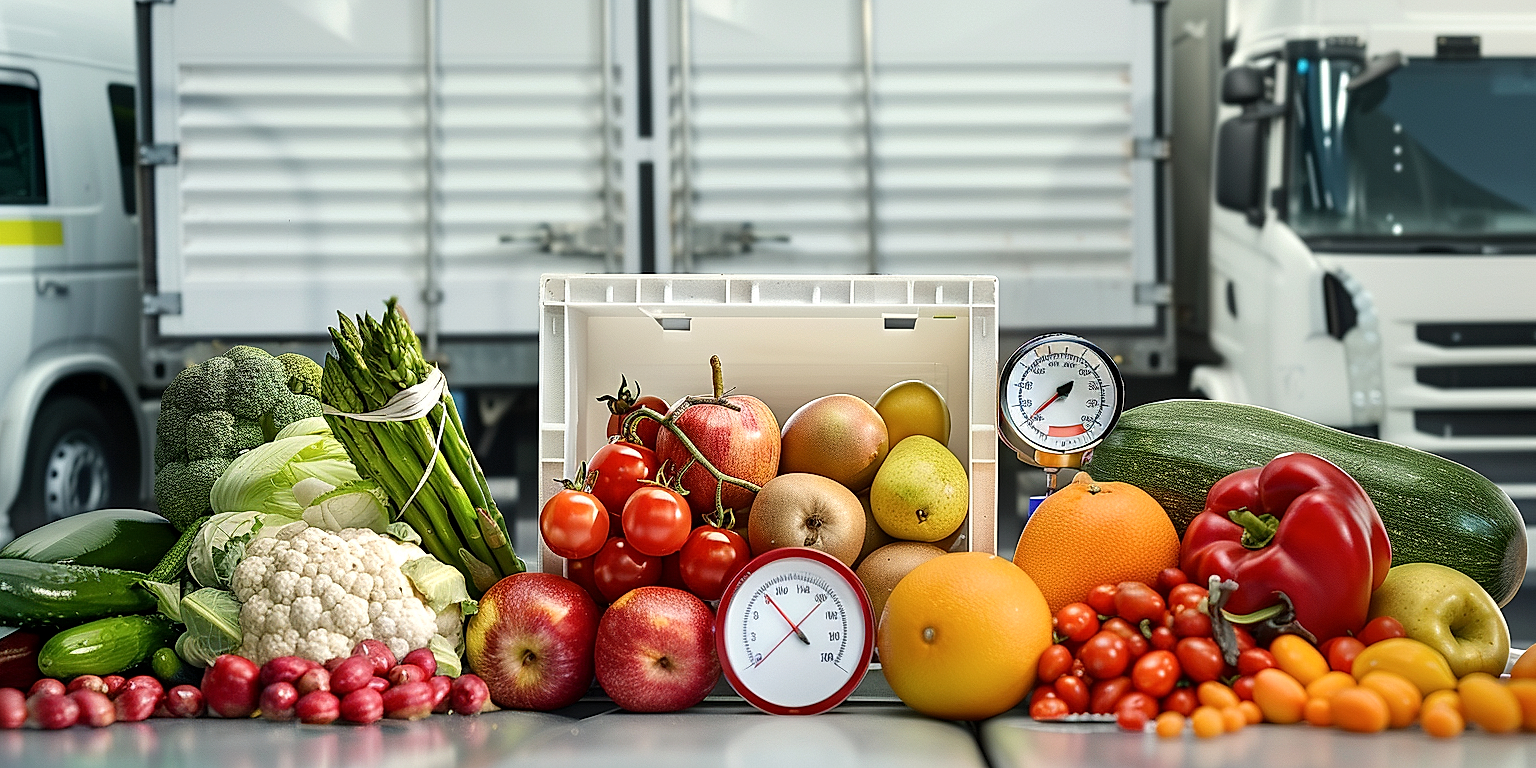Maintaining safety standards in the shipping of produce is both a legal requirement and a commitment to the consumer.
The stakes involve not only the financial implications but also the potential risk to human health.
Real-time tracking solutions are therefore vital.
They ensure that goods are monitored throughout the transportation process, from packaging to delivery.
We will delve into the various tracking mechanisms available to the industry in this piece.
Pioneering innovations in software and hardware are becoming increasingly prevalent, promising to revolutionize how we ensure the safety of produce during transit.
Tools For Monitoring Safety Standards In Produce Shipping
1. Food Safety Modernization Act Software
The Food Safety Modernization Act (FSMA) regulations present significant responsibilities for those in the food supply chain, particularly produce shippers.
One tool that proves to be incredibly valuable in this regard is FSMA compliance software.
This type of software is designed to aid in achieving and maintaining compliance with FSMA rules, automating various tasks and offering easy access to necessary information.
The software helps in managing compliance with regulations on preventive control, foreign supplier verification, sanitary transportation, and more.
It does this by automating the tracking of relevant activities, gathering and storing information, and generating reports needed for regulatory inspections and audits.
In essence, FSMA software transforms a traditionally complex, manual, and error-prone process into a simpler, automated, and highly accurate program.
What’s more, integrating FSMA software into produce shipping provides visible real-time data on compliance tasks, ones which include corrective actions, facilitating quick decisions.
The software is crucial in managing record-keeping requirements of FSMA, maintaining an electronic record of safety measures taken, incidents reported, and corrective actions undertaken.
With this data, shippers can easily demonstrate compliance with FSMA regulations during inspections.
The importance of FSMA software extends beyond compliance; it is equally critical for maintaining and improving food safety standards in produce shipping.
By providing a platform that can monitor, record, and report on various safety parameters, it facilitates a proactive approach to safety management.
The software empowers companies to identify potential issues or non-compliance early, enabling them to take immediate corrective actions and prevent major safety incidents.
Moreover, a credible FSMA compliance software solution can aid in building a robust food safety culture within a produce shipping company.
It can do this by providing visibility of FSMA regulations company-wide, enhancing training, and making everyone responsible for food safety.
Finally, it’s worth noting that the features and functionalities of FSMA software can vary, depending on the specific needs of the produce shipper.
However, choosing a reliable FSMA software solution can simplify compliance management, improve food safety practices, and consequently optimize the produce shipping process.
2. Temperature Tracking Devices
In the realm of produce shipping, maintaining proper temperature control is absolutely crucial.
Temperature deviations can lead to rapid deterioration of products, yielding increased waste and financial losses.
This is where temperature tracking devices come into the picture.
These devices constantly monitor and record the temperature within shipping containers, in real time, across the entire transportation journey.
They offer an invaluable tool for ensuring the safety and quality of shipped produce.
Temperature tracking devices can range from simple digital thermometers to more advanced systems incorporating wireless and cloud technologies.
The latter enables remote monitoring and automatic alerts if temperatures deviate outside of a predefined safe range.
This facilitates prompt intervention to prevent or mitigate any potential damage.
It’s typically possible to integrate temperature tracking devices with other systems, such as humidity control systems, for a more holistic monitoring approach.
Furthermore, the generated temperature data can be utilized for traceability purposes and can aid in the identification of bottlenecks or weak points in the shipping chain.
With respect to compliance, temperature tracking device data can help demonstrate adherence to Food Safety Modernization Act requirements or other relevant regulations.
These devices are particularly relevant for temperature-sensitive products such as fruits, vegetables, and fresh herbs.
It’s worth noting, however, that temperature tracking devices are not a panacea; they are one component of a comprehensive food safety strategy.
Overall, temperature tracking devices play a crucial role in maintaining the safety and quality of produce during shipping, thus upholding safety standards and promoting consumer trust.
3. Load Monitors
In the context of produce shipping, load monitors are an essential tool for maintaining safety standards.
The main function of load monitors is to keep track of the cargo weight throughout the shipping process.
By keeping a close watch on the load, it becomes possible to promptly detect any anomalies, such as unexpected weight changes that could suggest loss or damage to the produce.
This real-time tracking of cargo weight and related parameters makes load monitors instrumental in ensuring the integrity of the transported produce.
Moreover, load monitors are tailored to each specific shipping vehicle, ensuring accurate readings regardless of the vehicle’s type or size.
This allows for a reliable monitoring of a wide variety of shipments, from small batches to large quantities.
Most load monitors also include features that facilitate automatic data collection and analytics.
This can help shipping companies and produce suppliers to make informed decisions, optimize their operations and ensure the freshness and safety of their produce.
On the technical side, load monitors operate on the principle of measurement of force exerted by the weight of the cargo.
They make use of advanced technologies such as piezoelectric sensors, strain-gauge load cells, and hydraulic load cells, among others, to provide accurate measurements.
The reading is then digitally converted and presented in an easy-to-read format.
It’s important to note that the calibration of these devices is critical to ensuring accurate readings – hence regular maintenance and calibration are principal parts of load monitor usage.
For added convenience, many load monitors come with displays that can be mounted in the driver’s cabin, allowing for instant monitoring while on the move.
Overall, load monitors play a crucial role in maintaining safety standards during produce transportation by giving shippers the ability to constantly supervise the condition of their cargo.
As modern shipping operations continue to evolve, the demand for advanced load monitoring solutions is expected to grow, signaling a bright future for this tool in the industry.
Through ensuring the safety of the produce during shipment, load monitors indirectly contribute to the health and wellbeing of the consumers at the end of the supply chain.
Therefore, these tools are not just an investment for shipping companies, but also a safety assurance for the larger society.
4. Humidity Control Systems
The importance of humidity control systems cannot be overstated when discussing tools for monitoring safety standards in produce shipping.
These systems are designed to maintain optimal humidity levels within shipping containers and storage areas, thus preserving the quality of the produce.
A crucial aspect of these systems is their ability to prevent moisture-related issues such as mold growth, rot, and the premature ripening of fruits and vegetables.
With advancements in technology, today’s humidity control systems can automatically adjust humidity levels based on real-time measurements.
Not only does this conserve energy, but it also minimizes the risk of human error in setting the appropriate humidity levels for different types of produce.
Investment in a high-quality humidity control system is seen as a necessity rather than a luxury by most businesses in the produce shipping industry.
Such a system provides consistent conditions, essential for maintaining safety standards and ensuring the preservation of produce.
In addition to protecting the produce from humidity-related damages, these systems also maintain the freshness and nutritional value of the produce during transit.
This is particularly important for produce that is being shipped over long distances or to markets with differing climate conditions.
Most modern humidity control systems are designed to be user-friendly and require minimal maintenance, easing the operational burden on produce shipping companies.
Many systems also offer data logging capabilities allowing for a comprehensive analysis of humidity levels throughout the shipping process.
This data can be invaluable in identifying areas for improvement, ensuring optimal humidity conditions are maintained, and ultimately securing the quality and safety of the shipped produce.
It is also worth noting that while the upfront cost of humidity control systems can be significant, the potential financial losses that can be prevented through the use of such systems can make this a worthy investment.
Indeed, the value of ensuring produce reaches consumers in a fresh and safe condition can offset the costs associated with the installation and operation of these systems.
It’s clear, therefore, that humidity control systems are an essential tool in the arsenal of any produce shipping company committed to maintaining high safety standards.
5. Electronic Shipping Documentation
One of the key tools in maintaining safety standards in produce shipping is electronic shipping documentation.
This tool is designed to ensure transparency in the shipping process and to provide an audit trail for shipments of produce.
Electronic shipping documents carry crucial information, such as the origin of the produce, its handling details, and the conditions under which it was shipped.
These digital documents also make it easy to track the condition of the produce from the moment it leaves the farm to the time it reaches the consumer’s table.
In case of any safety issues, the electronic documentation is a reliable source of data for tracebacks.
This digital tracking and record-keeping method provides better access to records and improves regulatory compliance.
The software used in electronic documentation also incorporates real-time tracking, ensuring that each step during the storage and transportation process is recorded.
In the event of a discrepancy, it allows for a quick review and resolution, minimizing food safety risks.
Through electronic shipping documentation, there’s a greater certainty of food safety and quality controls, which are instrumental in preventing contamination outbreaks.
This tool has the ability to transform paper-based documentation into a more efficient and accurate digital format, making information instantly accessible.
It also improves operational efficiency by reducing the amount of time spent on paperwork and facilitates seamless information sharing.
By eliminating the need for physical documentation, it also reduces the risk of data loss or tampering.
Moreover, programs that support electronic shipping documentation are regularly updated to meet evolving safety standards and regulations.
In terms of customer service, it offers greater visibility to customers, allowing them to track their produce in real time.
The use of electronic shipping documentation reflects a commitment to transparency and accountability in ensuring food safety.
It is therefore an essential tool in the monitoring of safety standards in the produce shipping process.
6. GPS Tracking Systems
The role of GPS tracking systems has become crucial in implementing safety standards in produce shipping.
These systems provide real-time location tracking for shipped goods, ensuring the transparency of their movements.
By using these devices, produce sellers can monitor the exact route their products are taking to reach the end consumer.
As a result, any deviation from the planned route, potential delays, or unexpected events can be immediately identified and addressed.
Therefore, GPS tracking systems contribute significantly to reducing risks associated with produce shipping and increasing its overall safety and reliability.
One of the key features of modern GPS tracking systems is their integration capability. They can be easily synchronised with other digital tools, such as temperature tracking devices and load monitors.
Such a combination allows for a comprehensive inspection of produce shipping conditions and quick resolution of any potential issues.
The data collected by the GPS tracking systems can be analysed to identify trends and patterns in the shipping process.
These insights can be used to make the shipping routes more efficient and to further improve the safety standards.
Moreover, GPS tracking systems allow produce shipping companies to be more responsive to changes in the external environment.
For example, in case of bad weather conditions or road blockages, the systems can quickly suggest alternative routes.
GPS tracking can also be useful for timely communication with customers. With real-time tracking, customers can check the status of their order at any moment and plan their activities accordingly.
Nowadays, several competent GPS tracking systems are available in the market that provide a range of customisability options.
This allows companies to choose the system that best fits their specific requirements and industry standards.
To conclude, GPS tracking systems play an instrumental role in ensuring safety standards in produce shipping, allowing companies to monitor and manage the shipping process more efficiently and effectively.
7. Smartphone Applications
In the modern era, smartphones have become almost an essential part of our lives, with applications designed for virtually anything we can think of.
Produce shipping industry is no exception and has seen a rise in the development and adoption of numerous smartphone applications aimed at monitoring safety standards.
These applications serve various functions, ranging from monitoring temperatures in storage areas, generating shipping documentation, to tracking the entire shipping process.
With a simple tap, information can be accessed in real time, ensuring that safety standards are upheld at all times.
This real-time accessibility not only heightens the monitoring of safety standards but also optimizes the process of produce shipping.
Often, these apps come with an intuitive user interface and options for customization to suit the different needs of each produce shipping company.
For example, some apps allow for real-time notifications when the produce temperature exceeds a certain limit, enabling immediate action to be taken.
Additionally, they may have features that facilitate the calculation of transit times, and even estimation of arrival times, enhancing planning and efficiency.
Most of these smartphone applications also feature compatibility with other tools such as GPS tracking systems and temperature tracking devices, offering comprehensive monitoring solutions.
They can interact with internal systems to consolidate shipping data, hence shaving off administrative time and reducing chances of paperwork errors.
Moreover, using these applications not only supports compliance with regulations such as the Food Safety Modernization Act, but also contributes towards achieving best practices in the industry.
One of the significant benefits of using smartphone applications is the ability to maintain digital records for future reference or in case of audits.
It’s worth noting that despite the many advantages these applications bring, they still require responsible use, regular updates, and robust security measures to protect sensitive data.
When choosing a suitable application, it’s essential for produce shipping companies to consider factors such as the software’s features, reliability, and the support offered by the provider.
In conclusion, the advent of smartphone applications in produce shipping has revolutionized the process, enabling robust, meticulous, and timely tracking of safety standards, hence promoting the delivery of high-quality produce to consumers.
8. Quality Control Sampling Kits
Quality control is a fundamental aspect of maintaining safety standards in produce shipping.
One of the most critical tools in this process is the quality control sampling kit.
These kits are designed to help shippers regularly monitor the quality of the produce they are transporting.
The use of these kits allows shippers to perform routine tests to ensure the freshness and quality of the products.
Quality control sampling kits are thereby instrumental in preventing the shipment of subpar or hazardous produce.
The kits often contain a variety of tools, including sample containers, thermometers, and testing devices for pH levels, among other things.
Thermometers are used to monitor the temperature of the products, an essential factor in maintaining the freshness and safety of certain types of produce.
pH testing tools are useful for ensuring that produce is being stored in an environment with the appropriate acidity levels.
In addition, some kits may also include tools for testing the humidity levels and other environmental factors that can affect the quality of the produce.
Quality control sampling kits vary considerably, and it is important for shippers to choose kits that are tailored to their specific needs and the types of produce they are transporting.
The use of quality control sampling kits requires some level of technical knowledge in order to accurately interpret the test results and make informed decisions.
However, with proper training, shippers can utilize these tools to greatly improve the safety and quality of their shipments.
In conjunction with the other tools and technologies discussed in this article, such as temperature tracking devices and sanitary transport equipment, quality control sampling kits contribute significantly to maintaining safety standards in produce shipping.
Thus, quality control sampling kits are an essential tool for any shipper looking to guarantee safety and quality in their produce shipping operations.
Overall, these kits provide a practical and efficient method for monitoring and ensuring the quality of produce during transportation.
9. Sanitary Transport Equipment
In the realm of produce shipping, sanitary transport equipment plays a pivotal role in ensuring the safety standards are maintained.
When shipping fresh produce, it’s important to utilize equipment that can shield the food from potential contamination.
The key purpose of such equipment is to prevent direct and cross-contamination of the produce during transportation.
Sanitary transport equipment is designed with specific features that support cleanliness and food safety, facilitating smooth and safe delivery from farm to fork.
These mechanisms can significantly reduce the risk of microbial invasion, ensuring that the product stays fresh throughout the journey.
Equipment like sanitary conveyors, for instance, are built with specific materials that are resistant to bacteria and easy to clean.
Moreover, interior surfaces of the transport equipment are designed to prevent any accumulation of debris, which can pose a significant health hazard.
Precluding direct contact between produce and the equipment surface with these preventive measures can maintain the integrity of the shipment.
These equipment may also have in-built temperature and humidity control systems, safeguarding the produce from unfavorable environments during shipping.
Plus, with the use of state-of-the-art materials and technologies, the overall hygiene level of sanitary transport equipment has seen significant improvement.
These equipment also adhere to the Food Safety Modernization Act (FSMA) regulations laid down by the Food and Drug Administration (FDA).
Specific guidelines on sanitary transport outline proper cleaning procedures and the use of safe chemicals for sanitation purposes.
Furthermore, regular inspections and maintenance checks also form an integral part of the quality control process regarding the sanitation equipment during the shipping process.
Many of these sanitary transport equipment also comes designed with GPS tracking and load monitor features, helping to monitor the safety standard in a more comprehensive manner.
In essence, sanitary transport equipment in produce shipping not only secures the quality of food but also ensures adherence to mandated safety standards.
As a part of a larger ecosystem including diverse tools, equipment like temperature tracking devices, load monitors, and quality control sampling kits are used synergistically with sanitary transport equipment for optimal effectiveness.
10. Visual Inspection Tools
The role of visual inspection tools in maintaining safety standards in produce shipping can never be overstated.
Unlike many other technological solutions, visual inspection provides an immediate and tactile understanding of the condition of the produce.
Different visual inspection tools such as magnifying glasses, microscopes, and high-resolution cameras help in detecting potential safety threats at the microscopic level that might otherwise go unnoticed.
Given the potential of these tools, they are rapidly becoming an essential part of safety protocols in produce shipping.
These tools enable thorough examination of the physical characteristics of the produce such as size, shape, color and texture.
It is through meticulous visual inspections with these tools that diseased or damaged produce are identified and separated.
Furthermore, they provide a direct means to inspect produce for potential infestation by pests or other potentially harmful organisms.
High-resolution cameras, for instance, can capture images that, when magnified, reveal the presence of pests on the produce’s surface.
Similarly, microscopes and magnifying glasses can be used to inspect the internal structure of produce without damaging them.
Visual inspection tools also prove useful in verifying the effectiveness of other safety measures.
For instance, they can validate the accuracy of temperature and humidity controls, and check if the sanitary condition of transport equipment is up to standard.
Additionally, the results from visual inspections can be conveniently documented and shared digitally, improving transparency and accountability.
One of the biggest advantages of using visual inspection tools is that they require minimal training, making them accessible to a wide range of workers involved in produce shipping.
Many of these tools are also remarkably affordable, making them a cost-effective solution for ensuring the safety of produce during transportation.
While advancements in technology will inevitably lead to newer tools and methods for safety monitoring, the importance of visual inspection in produce shipping will persist.
It provides a level of granularity and comprehensiveness that other methods struggle to match.
The Bottom Line
With the progression of technology, the management of food safety has significantly improved, bringing efficiency and accuracy into the process.
Through the integration of the Food Safety Modernization Act software, temperature and load monitoring devices, humidity control systems, electronic shipping documentation, GPS tracking systems, smartphone applications, quality control sampling kits, sanitary transport equipment, and visual inspection tools, businesses can simplify their operations.
This not only protects consumers by ensuring the highest level of food safety standards are met but also secures companies’ growth and success within the market.
Therefore, investing in these technologically advanced tools isn’t just a matter of legal compliance, but a strategic profit-enhancing move in the ever-competitive food industry.




